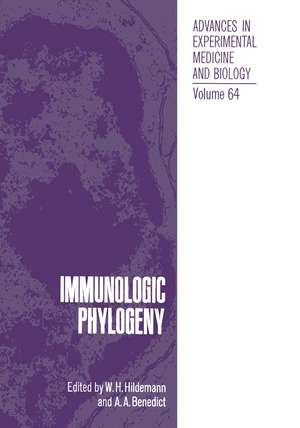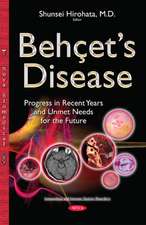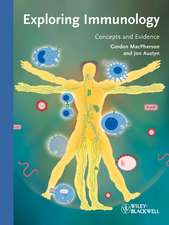Immunologic Phylogeny: Advances in Experimental Medicine and Biology, cartea 64
Editat de W. Hildemannen Limba Engleză Paperback – 20 iun 2013
Din seria Advances in Experimental Medicine and Biology
- 9%
 Preț: 719.56 lei
Preț: 719.56 lei - 5%
 Preț: 717.00 lei
Preț: 717.00 lei - 5%
 Preț: 717.00 lei
Preț: 717.00 lei - 15%
 Preț: 640.24 lei
Preț: 640.24 lei - 5%
 Preț: 715.71 lei
Preț: 715.71 lei - 5%
 Preț: 716.28 lei
Preț: 716.28 lei - 20%
 Preț: 691.93 lei
Preț: 691.93 lei - 5%
 Preț: 1031.00 lei
Preț: 1031.00 lei - 5%
 Preț: 820.42 lei
Preț: 820.42 lei - 5%
 Preț: 716.28 lei
Preț: 716.28 lei - 15%
 Preț: 641.38 lei
Preț: 641.38 lei - 5%
 Preț: 717.20 lei
Preț: 717.20 lei - 5%
 Preț: 715.35 lei
Preț: 715.35 lei - 5%
 Preț: 1113.83 lei
Preț: 1113.83 lei - 20%
 Preț: 1161.71 lei
Preț: 1161.71 lei - 5%
 Preț: 1170.51 lei
Preț: 1170.51 lei - 18%
 Preț: 1119.87 lei
Preț: 1119.87 lei - 5%
 Preț: 1288.48 lei
Preț: 1288.48 lei - 5%
 Preț: 1164.67 lei
Preț: 1164.67 lei - 5%
 Preț: 1101.73 lei
Preț: 1101.73 lei - 18%
 Preț: 1123.67 lei
Preț: 1123.67 lei - 5%
 Preț: 1435.64 lei
Preț: 1435.64 lei - 20%
 Preț: 1044.10 lei
Preț: 1044.10 lei - 18%
 Preț: 946.39 lei
Preț: 946.39 lei - 5%
 Preț: 292.57 lei
Preț: 292.57 lei - 18%
 Preț: 957.62 lei
Preț: 957.62 lei - 18%
 Preț: 1235.76 lei
Preț: 1235.76 lei - 5%
 Preț: 1231.55 lei
Preț: 1231.55 lei - 5%
 Preț: 1292.30 lei
Preț: 1292.30 lei - 5%
 Preț: 1102.10 lei
Preț: 1102.10 lei - 18%
 Preț: 1132.81 lei
Preț: 1132.81 lei - 5%
 Preț: 1165.19 lei
Preț: 1165.19 lei - 5%
 Preț: 1418.48 lei
Preț: 1418.48 lei - 5%
 Preț: 1305.63 lei
Preț: 1305.63 lei - 18%
 Preț: 1417.72 lei
Preț: 1417.72 lei - 18%
 Preț: 1412.99 lei
Preț: 1412.99 lei - 24%
 Preț: 806.15 lei
Preț: 806.15 lei - 18%
 Preț: 1243.29 lei
Preț: 1243.29 lei - 5%
 Preț: 1429.44 lei
Preț: 1429.44 lei - 5%
 Preț: 1618.70 lei
Preț: 1618.70 lei - 5%
 Preț: 1305.12 lei
Preț: 1305.12 lei - 18%
 Preț: 1124.92 lei
Preț: 1124.92 lei - 5%
 Preț: 1097.54 lei
Preț: 1097.54 lei - 15%
 Preț: 649.87 lei
Preț: 649.87 lei - 5%
 Preț: 1097.54 lei
Preț: 1097.54 lei - 18%
 Preț: 945.79 lei
Preț: 945.79 lei - 5%
 Preț: 1123.13 lei
Preț: 1123.13 lei - 20%
 Preț: 816.43 lei
Preț: 816.43 lei
Preț: 386.83 lei
Preț vechi: 407.19 lei
-5% Nou
Puncte Express: 580
Preț estimativ în valută:
74.02€ • 77.48$ • 61.61£
74.02€ • 77.48$ • 61.61£
Carte tipărită la comandă
Livrare economică 31 martie-14 aprilie
Preluare comenzi: 021 569.72.76
Specificații
ISBN-13: 9781468432633
ISBN-10: 146843263X
Pagini: 504
Ilustrații: XIV, 485 p. 83 illus.
Dimensiuni: 178 x 254 x 26 mm
Greutate: 0.87 kg
Ediția:Softcover reprint of the original 1st ed. 1975
Editura: Springer Us
Colecția Springer
Seria Advances in Experimental Medicine and Biology
Locul publicării:New York, NY, United States
ISBN-10: 146843263X
Pagini: 504
Ilustrații: XIV, 485 p. 83 illus.
Dimensiuni: 178 x 254 x 26 mm
Greutate: 0.87 kg
Ediția:Softcover reprint of the original 1st ed. 1975
Editura: Springer Us
Colecția Springer
Seria Advances in Experimental Medicine and Biology
Locul publicării:New York, NY, United States
Public țintă
ResearchCuprins
Tridacnin, a Potent Antigalactan Precipitin from the Hemolymph of Tridacna maxima.- Anti-Galactan Precipitins in the Hemolymph of Tridacna maxima and Limulus polyphemus.- Protectins in Argentine Mollusks: Immunological and Immunochemical Aspects.- Immunologic Significance of Specificities of Cellular Agglutinins of Limulus polyphemus.- Some Specific Aspects of Cell-Surface Recognition by Sipunculid Coelomocytes.- Response of Earthworm Leukocytes to Concanavalin A and Transplantation Antigens.- Recognition Factors of the Crayfish and the Generation of Diversity.- Endosymbiosis and Cellular Tolerance in the Hawaiian Soft Coral Sarcothelia edmondsoni Verrill.- Hard Tissue Tumors of Scleractinian Corals.- The Discriminatory Capacity of Phagocytic Cells in the Chiton (Liolophura gaimardi).- Direct Evidence of Heterolysis of Gorgonian Target Cells.- Immunoincompatibility Reactions in Corals (Coelenterata).- Allogeneic Distinction in Botryllus primigenus and in Other Colonial Ascidians.- Characteristics of Cell-Mediated Immunity and Memory in Annelids.- Specific Rejection of Integumentary Allografts by the Sea Star Dermasterias imbricata.- Preliminary Structural Characterization of Pacific Hagfish Immunoglobulin.- Antibodies against Salmonella and SRBC in Urodele Amphibians: Synthesis and Characterization.- Immunoglobulins in Ranid Frogs and Tadpoles.- Structural Data on Chicken IgA and Failure to Identify the IgA of the Tortoise.- Evolutionary Divergence of Immunoglobulin Constant Region Genes.- Evolution of Conformational Flexibility of Immunoglobulin M.- Relationship between Structure and Function of Lower Vertebrate Immunoglobulins.- Quantitative and Qualitative Aspects of the Antibody Library of Sharks.- Ultrastructure of Hagfish Blood Leucocytes.- Cell Surface Immunoglobulins of Thymus and Spleen Lymphocytes in Urodele Amphibian Pleurodeles waltlii (Salamandridae).- Structure and Immunological Function of Lymphomyeloid Organs in the Bullfrog Rana catesbeiana.- Lymphoid Organs and Amphibian Immunity.- Cellular Aspects of Humoral Immune Responsiveness in Chelydra.- Bursal and Thymic Alloantigen Expression in Lymphoid Tissues of the Chicken.- In Vitro Responses of Urodele Lymphoid Cells: Mitogenic and Mixed Lymphocyte Culture Reactivities.- Transplantation Immunogenetics and Mixed Lymphocyte Culture Reactivities of Partially Inbred Strains of Salamanders (A. mexicanum): Preliminary Studies.- Mitogens as Probes for Studying Temperature Effects on the Development of Immunocompetent Cells in Poikilothermic Vertebrates.- Synergistic and Antagonistic Effects of Mitogens on Proliferation of Lymphocytes from Spleens of Rana pipiens.- Mitogens as Probes of Lymphocyte Heterogeneity in Anuran Amphibians.- Thymic Function in Amphibians.- Phylogenetic Aspects of Hypersensitivity: Immediate Hypersensitivity Reactions in Flatfish.- Immunity in the Developing Amphibian.- Demonstration of an Inverse Relationship between Regenerative Capacity and Oncogenesis in the Adult Frog Rana pipiens.- Polyfunctional Antigen-Binding Specificity in Hapten-Carrier Responses of the Newt Triturus viridescens.- Surface Characteristics of Spleen Cell — Erythrocyte Rosette Formation in the Grass Frog Rana pipiens.- Phylogeny of Functional Humoral Transplantation Immunity: Comparative Studies in Amphibians and Rodents.- Genetic Control of Immune Responses in Chickens.- The Genetics of Chicken 7S Immunoglobulin Allotypes.- Use of the GVH Reaction to Investigate the Regulation of the Humoral Immune Response.- Immune Facilitation of Allograft Survival across RestrictedDifferences at the H-2 Compex.- Induction of Unresponsiveness to Organ Transplants in Congenic Strains of Rats and Other Mammals.- Many Questions (and Almost No Answers) about the Phylogenetic Origin of the Major Histocompatibility Complex.










